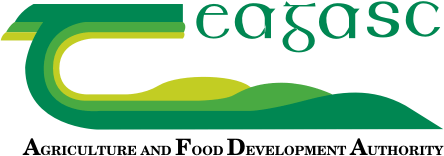November 2025 Future Beef Newsletter
Sign up to receive the Teagasc Future Beef Newsletter
Mark Kingston, Drimoleague, Co. Cork
Michael McGuigan – Farm Update | Technical Update: New: Future Beef Labour-Saving Series | Technical Update: Feed & Lying Space Allowance | Technical Update: Visual Assessment of Silage | Upcoming Events | Reminders | Top Tips for November | The Beef Edge Podcast
Upcoming Events
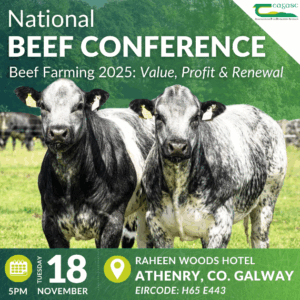
- Tuesday 18th November at 5pm: Join us at the National Beef Conference in the Raheen Woods Hotel, Athenry, where the theme “Beef Farming 2025: Value, Profit and Renewal” will take centre stage. Hear leading experts, including Rupert Claxton, Meat Director with GIRA, share insights on global beef market trends and price drivers for the year ahead, along with practical sessions on breeding high-value weanlings, improving farm profitability, and planning for generational renewal.
Reminders:
- 1st November: SCEP weights for calf and dam pairs must be recorded on ICBF by this date.
- 27th November: Last day to post genotype samples to ICBF for the Replacement Strategy action for 30th November deadline
Top Tips for November
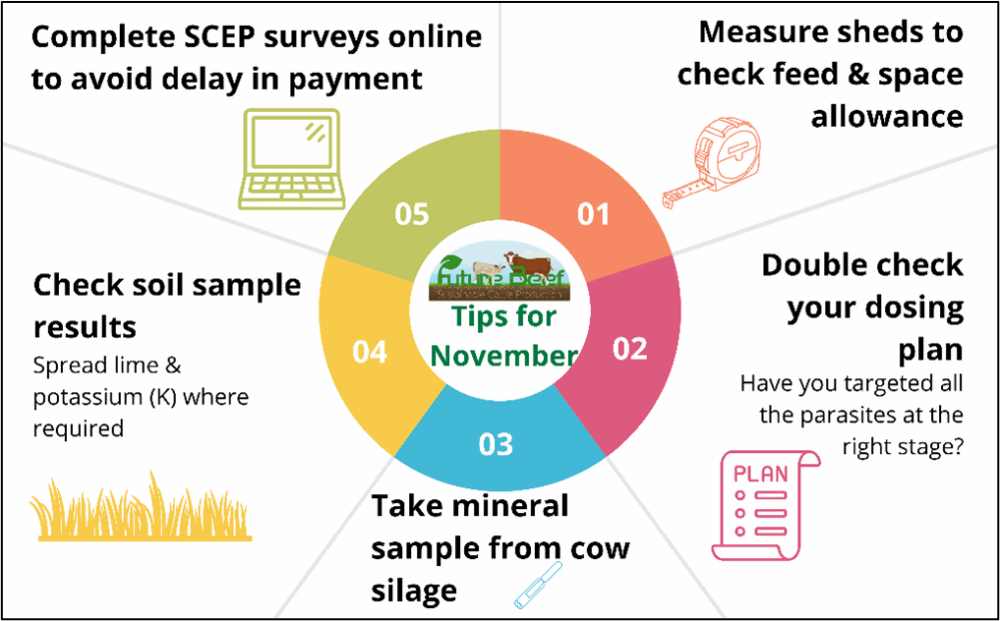
Farm Update: Mark & Diana Kingston

Mark Kingston
Mark and Diana Kingston farm near Drimoleague, Co. Cork, and are participants in both the Teagasc Future Beef and Signpost programmes. The Kingstons run a 32-cow suckler herd, calving eight in spring and 24 in autumn. The plan over the coming years is to move fully to an autumn-calving system to improve labour efficiency and make better use of grass.
All cattle are finished on the farm. Heifers are finished at around 23 months of age, while all male progeny are finished as under-16-month bulls. The herd is bred entirely through AI, with cows mainly Limousin × Simmental crosses. Replacement heifers calve at 24 months of age, and any cows not bred to maternal sires are served with high terminal index sires to improve carcass quality and farm output.
Current priorities on the farm include:
▶ commencing breeding in the autumn-calving herd;
▶ managing first-calved heifers to maintain body condition with good-quality silage and 1-2kg of concentrate per day;
▶ setting up paddocks for creep grazing autumn-born calves to help cows resume cycling;
▶ selecting AI sires for next year’s replacements;
▶ weaning the spring-calving herd and assessing cow condition; and,
▶ preparing housing for winter, including installing new feed barriers, pen divisions, repairing water troughs, and increasing lying space for finishing cattle.
Autumn-born bulls for finishing are currently being fed a high-maize finishing ration. Routine herd health work includes clipping cattle, treating for lice, dosing based on faecal samples, and monitoring factory feedback for signs of liver fluke.
Read more about Mark Kingston’s farm here.
Watch the video below where Mark outlines how he is managing the finishing bulls this autumn.
Farm update: Winter Grazing of Forage Crops in Co. Meath
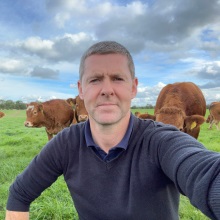
Michael’s forage crop has performed exceptionally well this season. It was sown with Interval, a hybrid forage rape that provides excellent winter feed for outwintered weanlings. To ensure good animal performance and protect soil and water quality, Michael follows best practice steps for winter grazing forage crops.
- Adaptation: Michael will gradually introduce cattle to the forage crop over 7–10 days to prevent bloat and toxicity. Silage will always be available to maintain rumen health and aid digestion.
- Fibre: Because forage brassicas are low in dry matter (8–16%), Michael ensures at least 30% of the diet comes from silage to maintain adequate fibre intake.
- Minerals: Brassicas are low in key trace elements. Before turnout, Michael will give a mineral bolus rich in iodine, copper, cobalt, and selenium to support animal health and growth.
- Water: Livestock will have constant access to clean, piped water, ensuring they do not drink directly from streams or watercourses, reducing contamination risks.
- Feeding: Michael supplements the weanlings with 2kg of ration per head daily. Feed troughs are placed 20 metres from watercourses and moved regularly to prevent poaching and runoff.
- Poisoning Prevention: To avoid nitrate toxicity, Michael will not move the wire or offer new crop during frost. Grazing will be completed before the crop flowers in mid-March.
- Lie-Back Area: A 30% lie-back area is provided with a firm, dry surface and good grass cover. This gives animals a comfortable resting space and helps prevent soil damage. Michael has inserted bungee cords along the length of the paddock so that the cattle will have multiple access gaps to the lie-back instead of entering and exiting through one gap.
- Buffer Zones: A 5-metre double-fenced buffer zone is maintained along the river, which remains uncultivated and ungrazed. This prevents nutrient and sediment runoff into waterways and supports GAEC 4 compliance.
- Grazing Management: Strip grazing is typically carried out towards the watercourse to control nutrient flow and ensure efficient crop utilisation. This system helps minimise soil compaction and maintains sward quality.
- Yield & Allocation: Michael assesses the yield and available dry matter (DM) in the crop to match animal demand. The temporary fence is moved daily to provide the correct allocation and maintain consistent feeding.
- Cross Compliance: To meet GAEC 4 (Good Agricultural and Environmental Condition) requirements, Michael implements practical soil protection measures. These include:
- Providing adequate lie-back areas
- Moving troughs and feeders regularly
- Avoiding leaking water troughs
- Limiting stock numbers during wet periods
- Reducing access through single gateways to prevent poaching
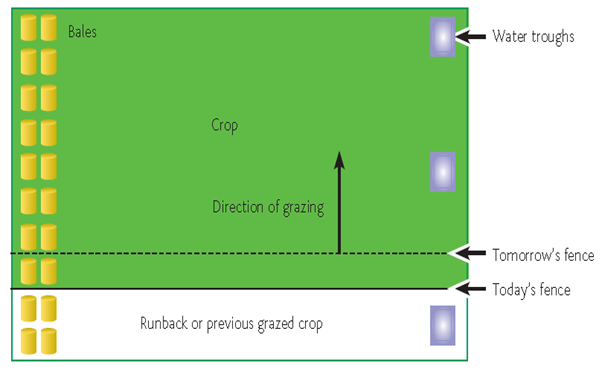
Recommended grazing management of the crop
You can read more from Michael’s farm here.
Technical Update: New: Future Beef Labour-Saving Series
The Future Beef Programme has launched a new video series featuring practical labour-saving ideas and technologies from beef farmers nationwide. Each short video highlights simple ways to boost efficiency, cut workload, and improve safety on farms. Watch the series on the Teagasc YouTube channel, with new videos released weekly on social media. See the first two below from Aonghusa Fahy in Co. Galway with his new handling pen and Wesley Browne in Co. Monaghan with his clipex fencing.
Technical Update: Feed & Lying Space Allowance
Providing the correct housing space for beef cattle during winter is crucial for beef farmers to safeguard welfare, performance and optimise returns. The key is ensuring each animal has adequate room — a cornerstone of good herd management.
Feeding Space Requirements
When feeding concentrates or ad lib roughage, allow the following:
- For concentrates: ~600-700 mm per head for cows and finishing cattle, 500-600 mm for light stores and 400-500 mm for weanlings.
- For ad-lib roughage: 400-500 mm for cows/finishers, 250-300 mm for light stores and 225-300mm for weanlings.
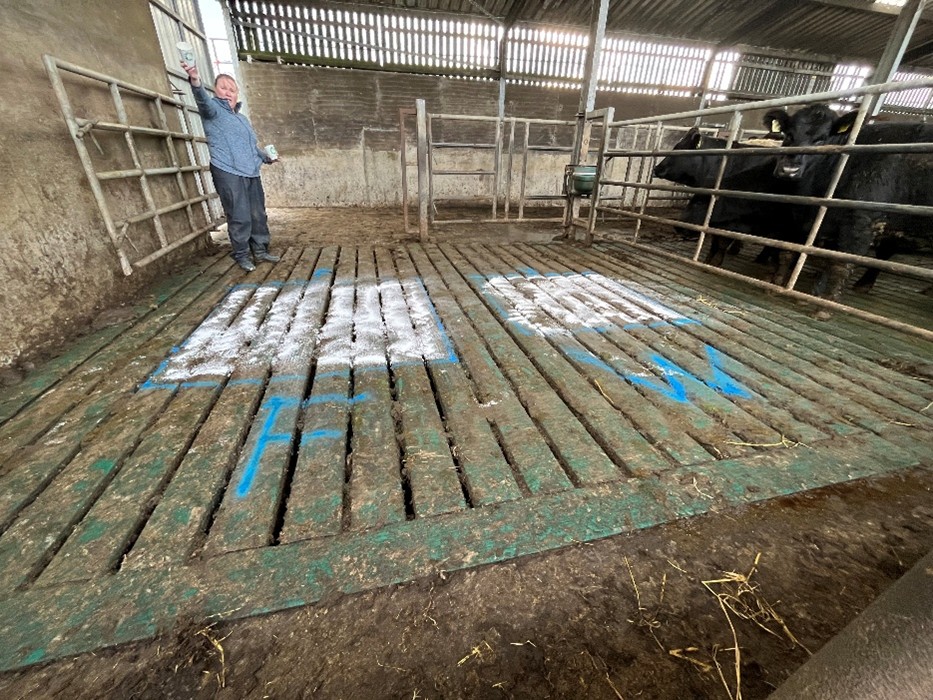
Beef specialist Catherine Egan demonstrating the lying space required for a finishing and weanling animal at a recent walk on Newford Farm
Recommended Housing Space Allowance (m² per head)
Under slatted or straw-bedded systems:
- Sucklers: 3 m² on slats, 4-5 m² for slats & straw; allow +1 m² for spring-born calves and +1.75 m² for autumn-born calves.
- Calves: <200 kg: 1.7 m² on straw; >220 kg: 1.8 m².
- Weanlings 220-300 kg: 1.2-1.5 m² (slats) / 1.8-3 m² (straw).
- Store cattle (310-450 kg): 1.5-2 m² (slats) / 2.4-3 m² (straw).
- Larger finishing animals (550-800 kg): increasing from ~2.2-2.9 m² (slats) up to ~4 m² (straw). Minimum recommendation is 2.7m2. Research shows 2 m² is insufficient for finishing cattle, while there’s no advantage above ~3 m².
Why it matters:
- Adequate space reduces stress, improves lying time and boosts performance — vital on beef farms.
- Over‐crowding leads to slower live weight gain, poorer feed conversion and higher labour for managing welfare.
- Having adequate lying space for finishing cattle can increase carcass weights in finishing cattle by 11kg per head.
You can read more here.
Technical Update – Visual Assessment of Silage
High-quality silage is essential for beef farmers in Ireland aiming to maintain animal performance and reduce meal costs. Assessing silage visually and manually provides quick insights into dry matter (DM), preservation, and feeding value.
Silage Sampling:
Core the silage pit at 2–4 diagonal points, discarding the first grab at each site. Avoid squeezing out too much moisture, as this gives an inaccurate DM reading.
Preservation & pH:
Good silage is bright green with a fruity or vinegary smell. Dark or olive colour and poor intake suggest high pH and poor fermentation.
Test pH from the middle of the pit (not the top). Ideal ranges:
- 18–20% DM: 3.8–4.2
- 24–28% DM: 4.4–4.6
- 28%+: up to 4.7
Cud-throwing can indicate silage with pH too low.
Dry Matter (DM):
DM below 30% can be estimated by squeezing a handful of silage:
- Juice flows easily: <20% DM
- Difficult to express: 20–25% DM
- Hands moist, little juice: 25–30% DM
For drier silage, compress it into a ball for 30 seconds and release:
- Holds shape with juice: <25% DM
- Holds shape, no juice: 25–30% DM
- Slowly falls apart: 30–40% DM
- Quickly falls apart: >40% DM
Feeding Value & DMD:
High-DMD silage feels soft, leafy, and rolls easily in your hand. More leaf and less stem indicate better digestibility:
- Very leafy: 76%+ DMD
- Leafy with stems: 68–75%
- Stemmy: <63%
Each week’s delay in cutting reduces DMD by 3 points—costing roughly 1kg of meal per head per day to maintain liveweight gain.
You can watch a video of carrying out the assessment below.
The Beef Edge Podcast
Keep up to date on all things beef on The Beef Edge Podcast weekly.

